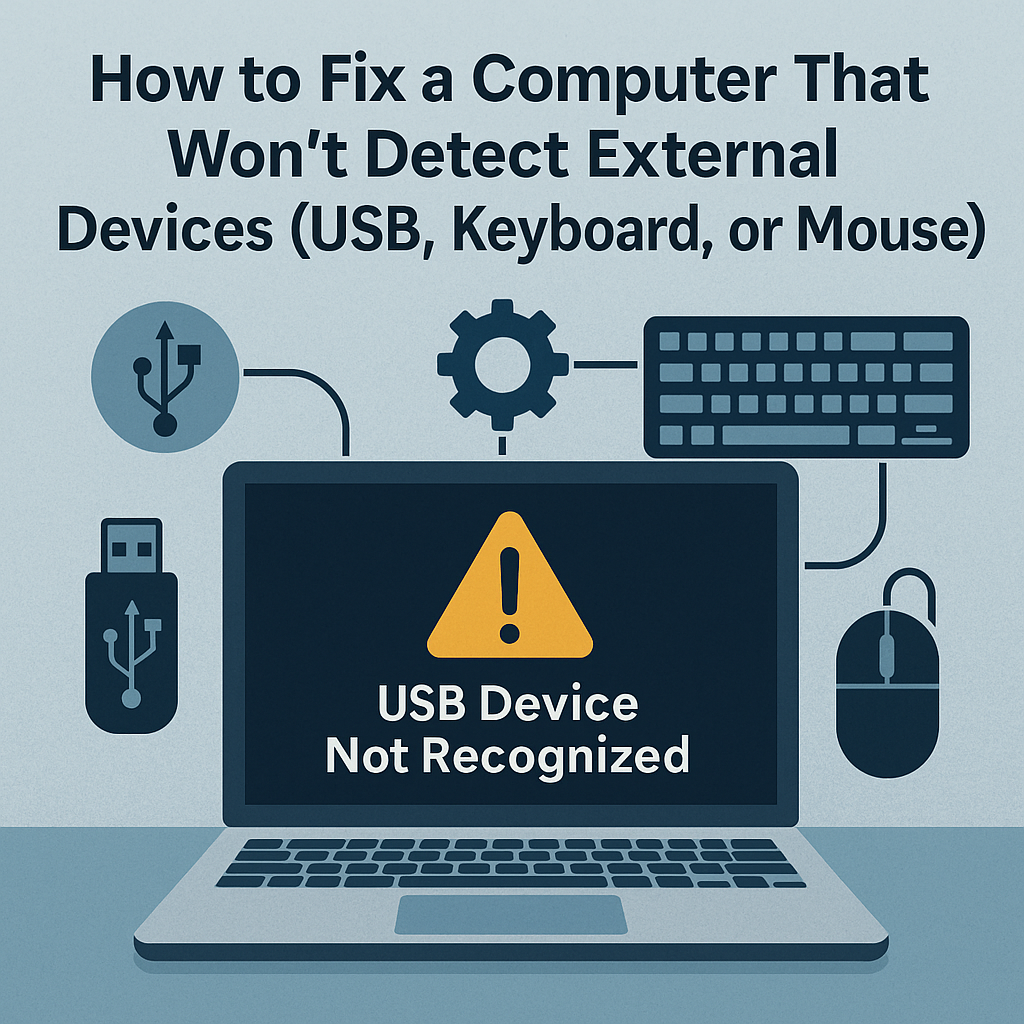Written By: Brent Schneider

You plug in your mouse or USB drive—and nothing happens. No sound, no light, no response. It’s one of those moments that make you wonder if your computer suddenly decided to ignore you.
External devices like USB drives, keyboards, and mice are essential for everyday computing. When your computer refuses to recognize them, it can disrupt work, cause data loss, or lead to hardware damage if ignored.
At S-Computing, we’ve handled thousands of such cases, from damaged USB ports to deep motherboard controller issues. This guide walks you through the most common causes—and the proven steps to fix them—without needing to be a tech expert.
Why Your Computer Fails to Detect External Devices
There are two broad categories of causes—hardware and software. Understanding which one you’re dealing with is key before applying any fixes.
1.1 Hardware Causes
1. Faulty or Loose USB Ports
One of the most common culprits is a physically damaged or loose USB port. Frequent plugging and unplugging, dust accumulation, or a bent connector can cause poor contact.
Symptoms:
- Device connects intermittently or only when held in a certain angle
- No LED light or power when connected
- Other USB ports still work
Quick Check:
Try the same device on another port. If it works there, you’ve confirmed a faulty port.
2. Power Supply Issues
USB ports need power. If your power supply (PSU) or motherboard isn’t delivering enough voltage—especially on desktops with many peripherals—devices might not initialize.
Tip:
Unplug unused USB devices. If you’re on a laptop, plug in the charger. Insufficient power can block recognition.
3. Broken Cables or Connectors
Sometimes the cable—not the computer—is the issue. Damaged USB cables can block both data and power transfer. Always test with a known-working cable.
4. Motherboard or Controller Damage
If no USB port works, you may have a failed USB controller on the motherboard. This often happens after power surges or liquid damage.
Solution:
Reset BIOS/UEFI and update chipset drivers (more below). If still not fixed, hardware service is needed—Book a Repair with S-Computing for diagnostics.
1.2 Software Causes
1. Corrupted Drivers
Drivers are small programs that tell your OS how to communicate with hardware. Corrupt, outdated, or conflicting drivers can easily cause detection problems.
Common signs:
- Device appears with a yellow triangle in Device Manager
- Message: “USB device not recognized”
- Device works fine on another computer
2. Power Management Settings
Windows sometimes disables idle ports to save power. While useful for laptops, it can prevent devices from reinitializing.
3. Faulty Updates or System Bugs
A bad Windows update or registry error can interfere with USB recognition. This often happens after large system patches or version upgrades.
4. Malware or Security Conflicts
Malware may hijack or disable ports to block detection. Some antivirus or encryption tools can also unintentionally interfere.
Step-by-Step Troubleshooting (Hardware + Software)
Let’s fix your detection issue using a systematic approach—from simplest to most technical.
Step 1: Rule Out the Device
Try your USB, mouse, or keyboard on another computer.
- If it works there → your computer is the issue.
- If it doesn’t → the external device itself is faulty.
Step 2: Try Different Ports and Cables
- Test every USB port.
- Use a short, high-quality cable.
- Avoid USB hubs during troubleshooting—connect directly to the PC.
If only some ports fail, you’re likely dealing with hardware failure on specific ports.
Step 3: Reboot and Power Cycle
A classic trick that works wonders.
- Turn off your computer.
- Unplug all external devices.
- Wait 1-2 minutes.
- Plug the power cable back and start the computer.
This resets power to USB controllers and often resolves stuck connections.
Step 4: Check Device Manager (Windows)
Open Device Manager (press Windows + X → Device Manager).
Expand Universal Serial Bus controllers or Keyboards/Mice and look for:
- ⚠️ Yellow triangle (driver issue)
- ❌ Red cross (disabled device)
Right-click → Uninstall device, then reboot. Windows will reinstall fresh drivers.
Step 5: Update or Roll Back Drivers
Outdated or faulty drivers are a major cause.
- Visit your motherboard or laptop manufacturer’s website.
- Download latest chipset, USB, and BIOS updates.
- Restart your computer after installation.
If your problem started after a driver update, roll back to a previous version instead.
Step 6: Disable USB Selective Suspend
Power management may disable ports automatically.
- Go to Control Panel → Power Options → Change plan settings → Advanced settings.
- Under USB settings, set USB selective suspend to Disabled.
Then restart your PC.
Step 7: Reset BIOS/UEFI
If all ports fail, BIOS may be corrupted.
- Enter BIOS (usually by pressing DEL or F2 during startup).
- Select Load Default Settings or Reset to Factory Defaults.
- Save and exit.
You can also update BIOS using manufacturer tools if you’re comfortable doing so.
Step 8: Check for Malware
Run a deep scan using Windows Defender or a trusted antivirus like Malwarebytes.
Malware can block access to ports or redirect input devices.
Step 9: Inspect Windows Services
Open Services.msc → ensure these are running:
- Plug and Play
- Device Install Service
- Human Interface Device Service
If stopped, right-click → Start.
Step 10: Try a Different Operating System (Optional)
If you suspect OS corruption, boot from a Linux USB or recovery drive.
If devices work there → the issue is software.
If not → hardware repair is required.
At this point, it’s best to contact a professional repair service like S-Computing to test the motherboard and USB controllers safely.
Advanced Fixes (For Persistent Cases)
1. Re-initialize USB Controllers
In Device Manager → Universal Serial Bus controllers → right-click each USB Root Hub → Uninstall → reboot.
This resets every USB connection.
2. Check Event Viewer Logs
Use Event Viewer to look for warnings or errors under:
Windows Logs → System → Source: Kernel-PnP or USBHUB.
These can point to the exact device or port causing the issue.
3. Check Registry for Corruption
(Advanced users only)
Open Registry Editor →HKEY_LOCAL_MACHINE\SYSTEM\CurrentControlSet\Services\USBSTOR
Ensure Start value is 3 (enabled).
If you’re unsure, skip this step or consult a professional.
4. Reinstall the Operating System
When all else fails, reinstall Windows or macOS fresh.
This clears hidden conflicts or registry corruption blocking device detection.
Before reinstalling, back up all data.
Prevention Tips
Once your devices are working again, keep them that way:
- Avoid cheap USB hubs and cables.
- Regularly clean ports with compressed air.
- Keep drivers and BIOS updated.
- Shut down your PC properly (don’t yank cables while powered).
- Use surge protectors to prevent port damage.
When to Seek Professional Help
If you’ve followed all the steps and your PC still won’t detect devices, it’s time for expert diagnostics.
At S-Computing, we specialize in:
- USB controller replacement
- Motherboard-level repairs
- Power and port diagnostics
- Data recovery from unrecognized drives
Book your service here: Book a Repair
Or visit: Our Locations
FAQs
Q1. Why does my computer detect my keyboard but not my USB drive?
Different USB power levels or driver assignments may cause selective recognition. Try different ports and disable selective suspend.
Q2. My mouse lights up but doesn’t move the cursor. Why?
That indicates power delivery but failed communication—likely a driver or software conflict.
Q3. Can a virus cause my USB ports to stop working?
Yes, certain malware disables ports to prevent file transfers. Run a full scan using a trusted antivirus.
Q4. Should I reset BIOS every time?
No. Only reset if all ports fail. Frequent resets can undo critical hardware settings.
Conclusion
A computer failing to detect external devices is more than an inconvenience—it’s often an early warning sign of deeper hardware or driver trouble.
By following this guide step-by-step, you can isolate whether the problem is caused by faulty ports, drivers, or firmware. If nothing works, professional diagnostics will save you time (and risk).
Disclaimer
This article is for educational purposes only. If you’re unsure about BIOS, registry, or motherboard-level work, consult a qualified technician.

